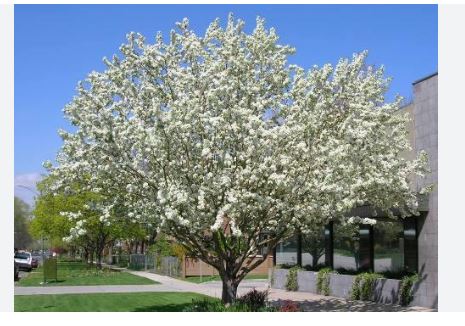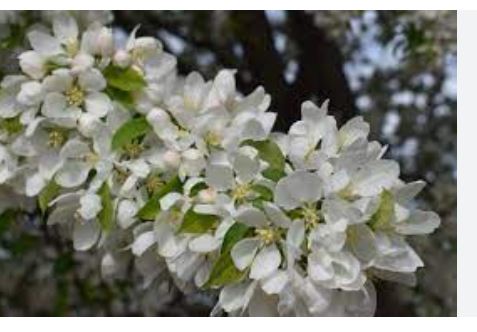
The Spring Snow Crabapple (Malus ‘Spring Snow’) is a stunning, fruitless ornamental tree celebrated for its profuse white blossoms, low-maintenance care, and urban adaptability. As a cultivar of the Malus genus in the Rosaceae family, this deciduous tree is a favorite for homeowners and landscapers seeking a clean, vibrant addition to small gardens, urban landscapes, or street plantings.
Botanical Classification
The Spring Snow Crabapple belongs to the following taxonomic classification:
- Kingdom: Plantae
- Phylum: Tracheophyta
- Class: Magnoliopsida
- Order: Rosales
- Family: Rosaceae
- Genus: Malus
- Cultivar: ‘Spring Snow’
The Malus genus encompasses both apples and crabapples, with crabapples typically distinguished by their smaller fruit (less than 2 inches in diameter). The Spring Snow Crabapple, however, is unique as a fruitless cultivar, bred specifically for ornamental qualities, eliminating the mess associated with fruit drop. This hybrid was developed through selective breeding to enhance its aesthetic appeal and disease resistance, making it a standout in the Malus genus.
History of the Spring Snow Crabapple
The Spring Snow Crabapple is a modern cultivar, likely developed in the late 20th century as part of breeding programs aimed at creating low-maintenance, fruitless crabapples for urban and residential landscapes. While specific details about its origin are less documented than other cultivars like the Adirondack Crabapple, it is believed to have been introduced in North America, possibly in Canada, given its reputation as a “Canadian gem” in some horticultural circles. The breeding focus was on producing a tree with profuse white blooms, a tidy growth habit, and minimal fruit production to reduce cleanup and pest issues.
Crabapples, in general, trace their origins to the mountainous regions of Central Asia, particularly Kazakhstan, where the wild apple species Malus sieversii is native. Crabapples spread across Europe and Asia via trade routes like the Silk Road and were introduced to North America by European colonists in the 17th century.
Native North American species, such as Malus coronaria (sweet crabapple) and Malus fusca (Pacific crabapple), also contributed to the genetic diversity of cultivated crabapples. The Spring Snow Crabapple represents a modern advancement, combining the ornamental beauty of its ancestors with practical traits suited for contemporary landscapes.
Native Area
As a cultivated hybrid, the Spring Snow Crabapple does not have a true “native” range but is derived from Malus species native to temperate regions of the Northern Hemisphere, including North America, Europe, and Asia. Its ancestral roots lie in Central Asia, particularly Kazakhstan, where wild Malus species thrive in mountainous regions.
Native North American crabapple species, such as Malus coronaria (eastern U.S.) and Malus fusca (Pacific Northwest and Alaska), may have contributed to its genetic lineage. The Spring Snow Crabapple was developed to thrive in a wide range of climates, particularly in North America, making it adaptable to urban and suburban settings across the continent.
Identifying Characteristics

The Spring Snow Crabapple is easily recognizable for its elegant form and vibrant seasonal displays.
- Size and Shape: This medium-sized deciduous tree grows to a height of 20–25 feet with a spread of 15–20 feet, forming a rounded, upright, or oval canopy with dense branching. Its symmetrical, compact form makes it ideal for small spaces and formal landscapes.
- Foliage: The leaves are ovate, simple, and serrated, measuring up to 3 inches long. They emerge bright green in spring, turning glossy and medium to dark green in summer, and transform into a vibrant golden-yellow in fall, adding seasonal interest.
- Flowers: The Spring Snow Crabapple is named for its profuse, fragrant, pure white flowers that blanket the tree in mid-spring (April–May). The flowers, which emerge from shell-pink or reddish buds, are single (5 petals) and arranged in clusters along the branches, creating a snow-like effect. The blooms attract pollinators like bees and butterflies, enhancing garden biodiversity.
- Fruit: Unlike most crabapples, the Spring Snow is fruitless, making it a clean option for landscapes where fallen fruit is undesirable. This trait reduces maintenance and minimizes pest attraction, as there are no pomes to drop.
- Bark: The bark is greyish-brown, smooth when young, and becomes slightly scaly or cracked with age. The branches are erect with a low-branching habit, which may require pruning to maintain clearance for walkways or patios.
- Growth Habit: The tree’s dense, oval, or upright form gives it a formal appearance, blending well into structured landscapes or as a focal point in informal gardens. Its low-branching structure may block views if not pruned properly.
Uses of the Spring Snow Crabapple
The Spring Snow Crabapple is primarily an ornamental tree, valued for its aesthetic contributions and low-maintenance care. Its uses include:
- Landscaping: The tree’s compact size, fruitless nature, and stunning spring blooms make it ideal for specimen planting, accent trees, patio trees, street trees, or privacy screens. It is particularly suited for urban landscapes, as it tolerates pollution and compacted soils. Its tidy form is perfect for small gardens, driveways, walkways, or highway medians, where fruit drop would be problematic.
- Wildlife Support: The fragrant flowers attract pollinators like bees and butterflies, supporting local ecosystems. While it lacks fruit, the tree still provides habitat and nesting opportunities for birds.
- Shade and Curb Appeal: With a mature height of 20–25 feet, the Spring Snow Crabapple provides partial shade for small yards or patios without overwhelming other plants. Its golden-yellow fall foliage and sculptural winter silhouette enhance year-round curb appeal.
- Formal Designs: When planted 10–15 feet apart, the tree’s canopy can form a privacy hedge or formal screen. It pairs well with shade-loving perennials like hostas or astilbes and contrasts beautifully with dark evergreens.
- Urban and Commercial Use: Its tolerance for urban conditions, including drought and poor drainage, makes it a popular choice for city parks, commercial properties, or parking lot islands.
- Bonsai and Espalier: The Spring Snow Crabapple can be trained as a bonsai or espalier for unique garden features, showcasing its versatility in small-scale or artistic plantings.
Growth Rate
The Spring Snow Crabapple has a moderate to fast growth rate, typically adding 12–24 inches per year. It reaches its mature height of 20–25 feet in approximately 10–15 years, making it a relatively quick-growing ornamental tree that provides visual impact without excessive wait time. Regular watering during the first three years helps establish a strong root system, after which the tree requires minimal care.
USDA Hardiness Zones
The Spring Snow Crabapple thrives in USDA Hardiness Zones 3–8 (sometimes listed as 3A–8A or 3–7), making it suitable for a wide range of climates, from cold northern regions to warmer southern areas, including northern Texas and Oklahoma. It prefers full sun (at least 6 hours daily) to maximize flowering and growth, though it tolerates partial shade with reduced bloom production.
The tree performs best in well-drained, slightly acidic soils (pH 5.5–6.8) but adapts to various soil types, including loam, clay, or compacted urban soils. It is drought-tolerant once established and moderately tolerant of salt spray, though excessive road salt exposure should be avoided.
Fun Fact
The Spring Snow Crabapple is often considered the only completely fruitless crabapple cultivar, making it a unique choice for gardeners who love the beauty of crabapple blooms but dislike the mess of fallen fruit. Its snow-like spring blossoms inspired its name, creating a breathtaking display that resembles a light dusting of snow, earning it a reputation as a “showstopper” in spring landscapes.
Care and Maintenance Tips
To ensure the Spring Snow Crabapple thrives, follow these care tips:
- Planting: Choose a site with full sun and well-drained soil. Dig a hole twice as wide and as deep as the root ball, spreading roots carefully. Apply a 2–3-inch layer of organic mulch (e.g., bark chips) around the base, keeping it away from the trunk to prevent rot.
- Watering: Water regularly during the first three years to establish roots, providing about 1 inch of water per week. Once established, water only during prolonged dry spells or extreme heat.
- Pruning: Prune in late winter or early spring before flowering to remove dead, diseased, or crossing branches and to maintain clearance under low branches. Minimal pruning is needed due to the tree’s tidy form, but early training ensures a strong structure.
- Fertilization: Apply a light layer of compost or balanced fertilizer in spring to support growth. Avoid over-fertilizing, as excess nitrogen can increase disease susceptibility.
- Pest and Disease Control: While the Spring Snow Crabapple has good resistance to powdery mildew, it is less resistant to diseases like apple scab, fire blight, and cedar-apple rust compared to cultivars like Adirondack. Monitor for leaf spots, wilting, or blackened branches, and treat promptly with fungicides or sterile pruning if needed. Check for pests like aphids or mites, which are typically minor issues.
- Site Selection: Plant at least 10–15 feet from buildings to avoid low branches obstructing views or walkways. Avoid areas with heavy road salt exposure.
Challenges and Considerations
While the Spring Snow Crabapple is low-maintenance, there are a few considerations:
- Disease Susceptibility: Unlike some crabapple cultivars, Spring Snow is not highly resistant to apple scab, fire blight, or cedar-apple rust, particularly in humid or wet climates. Regular monitoring and good air circulation are essential.
- Seasonal Cleanup: Although fruitless, the tree sheds petals in spring and leaves in fall, requiring some cleanup in high-traffic areas.
- Salt Sensitivity: The tree is only moderately tolerant of salt spray and may suffer in areas with heavy road salt use.
- Shade Limitations: Partial shade reduces flower production and may increase disease risk. Full sun is ideal for optimal performance.